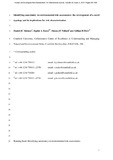JavaScript is disabled for your browser. Some features of this site may not work without it.
| dc.contributor.author | Skinner, Daniel J. C. | - |
| dc.contributor.author | Rocks, Sophie A. | - |
| dc.contributor.author | Pollard, Simon J. T. | - |
| dc.contributor.author | Drew, Gillian H. | - |
| dc.date.accessioned | 2014-09-24T04:00:46Z | |
| dc.date.available | 2014-09-24T04:00:46Z | |
| dc.date.issued | 2014-12-31T00:00:00Z | - |
| dc.identifier.citation | Daniel J. C. Skinner, Sophie A. Rocks, Simon J. T. Pollard & Gillian H. Drew, Identifying uncertainty in environmental risk assessments: the development of a novel typology and Its implications for risk characterisation, Human and Ecological Risk Assessment: An International Journal, Volume 20, Issue 3, 2014, Pages 607-640. | |
| dc.identifier.issn | 1080-7039 | - |
| dc.identifier.uri | http://dx.doi.org/10.1080/10807039.2013.779899 | - |
| dc.identifier.uri | http://dspace.lib.cranfield.ac.uk/handle/1826/8698 | |
| dc.description.abstract | Environmental risk analysts need to draw from a clear typology of uncertainties when qualifying risk estimates and/or significance statements about risk. However, categorisations of uncertainty within existing typologies are largely overlapping, contradictory, and subjective, and many typologies are not designed with environmental risk assessments (ERAs) in mind. In an attempt to rectify these issues, this research provides a new categorisation of uncertainties based, for the first time, on the appraisal of a large subset of ERAs, namely 171 peer-reviewed environmental weight-of-evidence assessments. Using this dataset, a defensible typology consisting of seven types of uncertainty (data, language, system, extrapolation, variability, model, and decision) and 20 related sub-types is developed. Relationships between uncertainties and the techniques used to manage them are also identified and statistically evaluated. A highly preferred uncertainty management option is to take no action when faced with uncertainty, although where techniques are applied they are commensurate with the uncertainty in question. Key observations are applied in the form of guidance for dealing with uncertainty, demonstrated through ERAs of genetically modified higher plants in the European Union. The presented typology and accompanying guidance will have positive implications for the identification, prioritisation, and management of uncertainty during risk characterisation. | en_UK |
| dc.language.iso | en_UK | - |
| dc.publisher | Taylor & Francis | en_UK |
| dc.rights | This is a preprint of an article whose final and definitive form has been published in the Ecological Risk Assessment: An International Journal 2014 copyright Taylor & Francis Ecological Risk Assessment: An International Journal is available online at: http://www.tandfonline.com/doi/abs/10.1080/10807039.2013.779899#.VCptARawSMs | |
| dc.title | Identifying uncertainty in environmental risk assessments: the development of a novel typology and Its implications for risk characterisation | en_UK |
| dc.type | Article | - |
Files in this item
This item appears in the following Collection(s)
-
Staff publications (SAS) [907]
